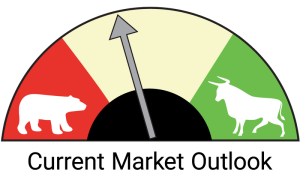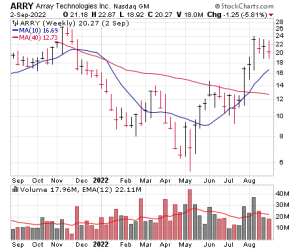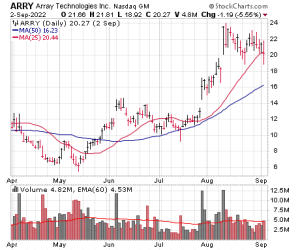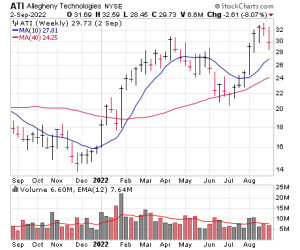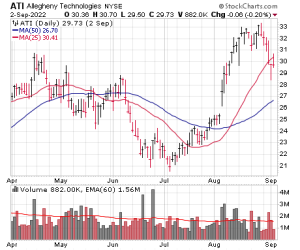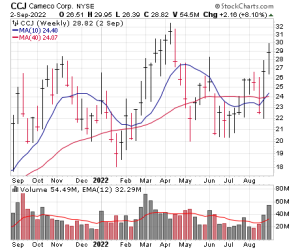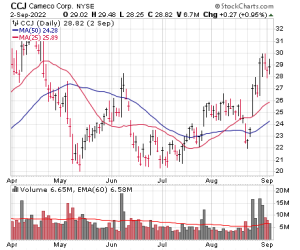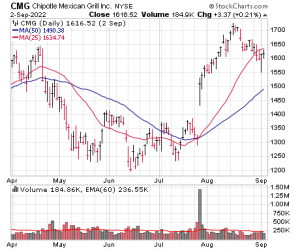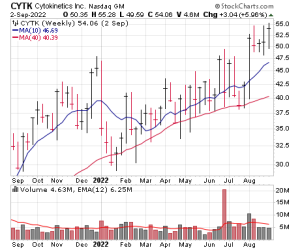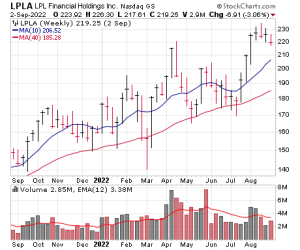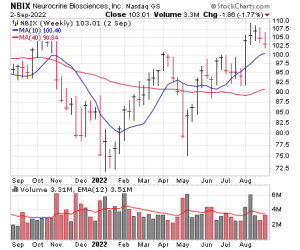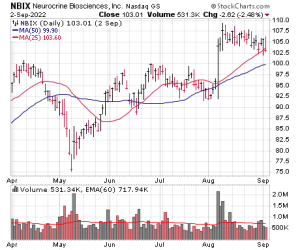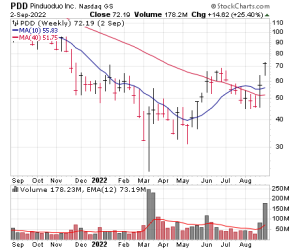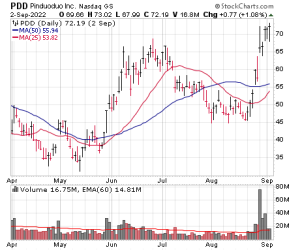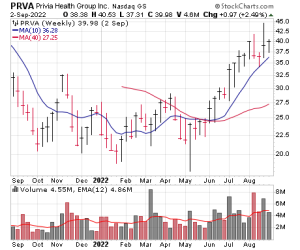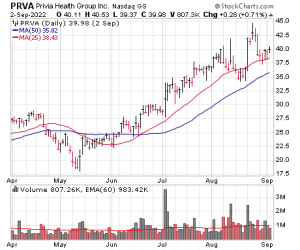We’re still thinking there’s a decent chance that the market’s action since May and June is part of a big bottoming process, but it’s also pretty clear that, even if that’s true, the market has more work to do—the selling of the past three weeks has erased many of the positive top-down signals from the prior month or two, with the intermediate-term trend of the major indexes pointed down, the broad market unhealthy and growth stocks in general again underperforming. We’re still aiming to hold onto resilient names, but having plenty of cash is also a must, as is staying flexible.
This week’s list has a bunch of good charts, reflecting the fact that many nooks and crannies of the market are still looking somewhat solid. Our Top Pick is a leader in a commodity niche that has a good launching pad and has come under strong accumulation.
Cabot Top Ten Trader Issue: September 6, 2022
DOWNLOAD ISSUE PDF
More Work to DoWe’re still thinking there’s a decent chance that the market’s action since May and June is part of a big bottoming process, where more and more stocks and sectors hit their nadirs as the weeks and months pass, and more and more investors throw in the towel, wiping away the weak hands. Thus, now’s not the time to stick your head in the sand; there are still plenty of stocks that took off nicely in July and early August and are acting normally. However, it’s also pretty clear that, even if we are in a drawn out bottoming process, the market has more work to do—the selling of the past three weeks has erased many of the positive top-down signals from the prior month or two, with the intermediate-term trend of the major indexes pointed down, the broad market unhealthy (many stocks hitting new lows each day) and growth stocks in general (which usually lead coming out of a bear) again underperforming. We’re still aiming to hold onto resilient names, but having plenty of cash is also a must, as is staying flexible. Our Market Monitor now stands at a level 4.
This week’s list has a bunch of good charts, reflecting the fact that many nooks and crannies of the market are still looking somewhat solid. Our Top Pick is Cameco (CCJ), the uranium leader, which has etched a nice launching pad for months and is now under strong accumulation.
| Stock Name | Price | Buy Range | Loss Limit |
| Array Technologies (ARRY) | 21 | 19.5-21 | 16-17 |
| ATI Inc. (ATI) | 30 | 28-29.5 | 25.5-26.5 |
| Cameco (CCJ) ★ TOP PICK ★ | 29 | 27.5-29 | 24.5-25.5 |
| Chipotle Mexican Grill (CMG) | 1632 | 1590-1640 | 1440-1460 |
| Cytokinetics (CYTK) | 49 | 48-50 | 44-45 |
| LPL Financial (LPLA) | 220 | 215-222 | 197-200 |
| Neurocrine Bio (NBIX) | 103 | 101-104 | 92-94 |
| Pinduoduo (PDD) | 67 | 62-65 | 54-56 |
| Privia Health Group (PRVA) | 38 | 37-39 | 33-34 |
| TripAdvisor (TRIP) | 23 | 25-26 | 21-22 |
Stock 1
Array Technologies (ARRY)
| Price | Buy Range | Loss Limit |
| 21 | 19.5-21 | 16-17 |
Why the Strength
Solar stocks remain in pole position to be among the leading groups of the next sustained bull run (we’ve written up a couple others in recent weeks), and Array Technologies is another firm involved in maximizing the potential of solar arrays. The firm has one of the industry’s best tracking systems, which are used mostly in utility-scale projects to rotate a group of solar modules throughout the day to keep them pointed at an optimal angle to the sun, which in turn maximizes power output. The industry as a whole is growing quickly, with 88% of new ground-mounted solar arrays using some sort of tracker, and Array claims its systems enable a 25% boost in power and “only” increases the project’s build cost by 11%; it also says its offering lasts 30 years with minimal upkeep, so the payback on trackers should be many-fold over time. The firm is the leader in the U.S., which is big, but it’s also the top dog in Latin America and a top five player in Europe (thanks in part to a recent buyout), too. Array grew decently early this year despite tons of module and project delays due to some tricky regulations, but that seems to be in the past—Array’s organic order book was up 67% in Q2 from a year ago, while revenues more than doubled and earnings leapt into the black—and more important, the tariff relief earlier this year and green energy bill a few weeks ago promises to keep demand moving higher, with Wall Street expecting a 25% revenue boost next year while earnings triple, both of which could prove conservative. All in all, Arrays looks like a nuts-and-bolts way to play the solar boom.
Technical Analysis
ARRY came public in Q4 of 2020, rallied for a quarter and then was destroyed, falling nearly 90% from the top to its bottom in May of this year. From there, the stock did quickly bounce back to its 40-week line, but the fireworks came after another two-month rest—ARRY exploded from 14 to 23 in a just three weeks, and more impressively, it’s held most of those gains despite the market’s sloppy action of late. It’s aggressive, but you could nibble here with a loose stop near the 50-day line.
| Market Cap | $3.02B | EPS $ Annual (Dec) | |
| Forward P/E | 67 | FY 2020 | 0.89 |
| Current P/E | N/A | FY 2021 | 0.04 |
| Annual Revenue | $1.14B | FY 2022e | 0.30 |
| Profit Margin | 3.3% | FY 2023e | 0.94 |
| Qtrly Rev | Qtrly Rev Growth | Qtrly EPS | Qtrly EPS Growth |
| ($M) | (vs. yr-ago-qtr) | ($) | (vs.yr-ago-qtr) |
| Latest qtr | 425 | 116% | 0.09 | 250% |
| One qtr ago | 301 | 21% | -0.02 | N/A |
| Two qtrs ago | 220 | 22% | -0.06 | N/A |
| Three qtrs ago | 192 | 38% | -0.07 | N/A |
Stock 2
ATI Inc. (ATI)
| Price | Buy Range | Loss Limit |
| 30 | 28-29.5 | 25.5-26.5 |
Why the Strength
Allegheny (covered in the August 8 report) specializes in producing titanium- and nickel-based alloys, stainless steel and specialty components for the global aerospace and defense markets (44% of sales), including next-generation jet engine components and 3D-printed aerospace products. A recent survey revealed that three out of four aerospace industry executives expect their firm’s revenues to increase over the next 15 months, a positive in this uncertain economic environment and something that bodes well for the jet engine market Allegheny serves. Along those lines, the company reports demand for its wide-body engine spare parts is “spiking” as airlines react to the strength in international travel. Another big growth driver for the company is the war in Ukraine, which has forced many players in the industry to shift their titanium purchases (a key aerospace metal) to Western sources like Allegheny. For example, Allegheny just announced a major multi-year agreement to supply Britain’s GKN Aerospace with titanium materials used to make commercial and military airframes. Allegheny also has an expanding footprint in the energy sector, which accounts for around 20% of its sales, and reports “strong” demand from the oil and gas markets driven by elevated oil prices and energy security needs resulting from Russia’s invasion. In Q2, management said the energy segment saw 70% demand growth from a year ago (and up 25% sequentially), as high oil prices enticed customers to fund exploration and expansion projects. Additionally, the company sees long-term growth in its specialty energy segment (including alloys used in solar, wind and nuclear plants) arising from sustainable energy conversions. Analysts see earnings mushrooming this year and up another 19% in 2023, which should prove low.
Technical Analysis
We missed our entry price for ATI last month, but we’re willing to take another swing after the recent pullback. Earnings provided the catalyst to new highs last month, and despite the dip last week, ATI has shown far more resilience than the broad market by remaining well above the 50-day line and in the vicinity of its recent breakout. More volatility is still possible, near-term, but we think the stock offers a decent risk-reward situation around here.
| Market Cap | $3.71B | EPS $ Annual (Dec) | |
| Forward P/E | 15 | FY 2020 | -0.52 |
| Current P/E | 24 | FY 2021 | 0.13 |
| Annual Revenue | $3.29B | FY 2022e | 1.96 |
| Profit Margin | 8.0% | FY 2023e | 2.34 |
| Qtrly Rev | Qtrly Rev Growth | Qtrly EPS | Qtrly EPS Growth |
| ($M) | (vs. yr-ago-qtr) | ($) | (vs.yr-ago-qtr) |
| Latest qtr | 960 | 56% | 0.54 | N/A |
| One qtr ago | 834 | 20% | 0.40 | N/A |
| Two qtrs ago | 765 | 16% | 0.25 | N/A |
| Three qtrs ago | 726 | 21% | 0.05 | N/A |
Stock 3
Cameco (CCJ) ★ TOP PICK ★
| Price | Buy Range | Loss Limit |
| 29 | 27.5-29 | 24.5-25.5 |
Why the Strength
The global energy crisis has catapulted uranium back into the headlines, with energy security concerns and government-sponsored green energy initiatives helping the cause. Other demand drivers include a major nuclear policy reversal from Japan’s government (a big reason for the stock’s recent push higher), plus India’s plan to build a massive nuclear reactor, as both countries try to move away from coal and natural gas imports. Moreover, as the world moves away from Russia-enriched uranium supplies, Cameco—one of the world’s largest uranium miners—is becoming more attractive in the bid to fill the sizable demand gap. The company recently made its own headlines when it announced a restart of operations at its McArthur River mine (the world’s largest high-grade uranium deposit), which closed in 2018. Cameco’s management said it plans to operate the mine at a “lower-than-full-capacity rate,” adding that the company is “still in supply discipline mode,” which should provide the market with more of the coveted energy source while allowing prices to remain firm. Meanwhile, as geopolitical factors continue to highlight supply concerns, Cameco managed to benefit from realized uranium prices that were 41% higher than a year ago, as well as higher fuel service sales prices (up 8%) in Q2. Revenue of $558 million jumped 55% from a year ago while blowing past Wall Street’s expectations; per-share earnings of 18 cents also crushed the consensus (by 17 cents). Maybe most importantly, Cameco added 45 million pounds to its portfolio of long-term uranium contracts in the first half of 2022, with a “significant and growing pipeline” of further contract discussions underway (i.e., this isn’t just a play on current uranium prices). After many false starts over the years, Wall Street sees Cameco’s bottom line lifting rapidly through at least next year.
Technical Analysis
CCJ hit a yearly peak back in April at 32, but turned tail and dropped to 20 a month later as uranium stocks fell out of favor and, of course, the market collapsed. Unlike many of its industry peers, however, the stock bottomed that month and spent the next 14 weeks testing support in the low 20s, holding every time—and the past two weeks have seen the buyers back at it (spurred on by the Japan news), with big-volume gains. CCJ is usually pretty herky-jerky, but we’re not opposed to starting a position here or (preferably) on dips.
| Market Cap | $11.5B | EPS $ Annual (Dec) | |
| Forward P/E | 116 | FY 2020 | -0.17 |
| Current P/E | 268 | FY 2021 | -0.25 |
| Annual Revenue | $1.78B | FY 2022e | 0.25 |
| Profit Margin | 12.9% | FY 2023e | 0.69 |
| Qtrly Rev | Qtrly Rev Growth | Qtrly EPS | Qtrly EPS Growth |
| ($M) | (vs. yr-ago-qtr) | ($) | (vs.yr-ago-qtr) |
| Latest qtr | 558 | 55% | 0.18 | N/A |
| One qtr ago | 398 | 37% | 0.04 | N/A |
| Two qtrs ago | 465 | -16% | 0.06 | -50% |
| Three qtrs ago | 361 | -5% | -0.14 | N/A |
Stock 4
Chipotle Mexican Grill (CMG)
| Price | Buy Range | Loss Limit |
| 1632 | 1590-1640 | 1440-1460 |
Why the Strength
A heavy focus on digital sales during the pandemic is paying off for Chipotle, and now that in-person dining has returned, the company expects to more than double its locations across the U.S. and Canada long-term. The Mexican-inspired fast-casual dining restaurant expects to eventually have 7,000 locations across North America (from the current 3,052)—a 17% improvement from its expectations last year as Chipotle’s cookie-cutter story continues. But it’s important to note the firm is innovating and adapting even when it comes to expansion—the company is placing a growing emphasis on drive-through sales, with 80% of planned new restaurants this year having a drive-through option (which the company has dubbed Chipotlane). What’s more, the company has been opening a growing number of digital-only stores since 2020, called Chipotle Digital Kitchen; digital sales as a whole made up 39% of revenue in Q2. Key to Chipotle’s digital-based success was the 2019 introduction of a rewards program, which is tracking towards $3.5 billion in revenue and now has nearly 30 million members, allowing the company to tailor offers based on a customer’s taste preferences. (We use it, and the rewards are pretty solid.) Meanwhile, on-premise sales grew a whopping 36% during the second quarter as in-store dining came back. Put together, all of this helped drive a 17% year-over-year increase in revenue during Q2, to $2.2 billion, with per-share earnings of $9.30 beating estimates by 27 cents. Other highlights in the quarter included operating margin of 15% (up from 13%), and the opening of 42 new restaurants, 32 of which had a Chipotlane. Management expects comparable restaurant sales growth in the mid-to-high-single digits this year (including recently planned price increases), while Wall Street sees 30% bottom line growth through at least 2023.
Technical Analysis
After experiencing a powerful run from April 2020 to last September, CMG hit a wall at 1,950 and immediately started a sled ride that brought the stock down to 1,240 in May. Then came the bottom-building process, which took a couple of months, followed by the Q2 report, which led to not just a gap up but a solid follow-through rally. The retreat of the past two weeks has been very tame—we’re fine grabbing a few shares here if you want in. As for the price of the stock, just buy fewer shares.
| Market Cap | $44.6B | EPS $ Annual (Dec) | |
| Forward P/E | 49 | FY 2020 | 10.73 |
| Current P/E | 58 | FY 2021 | 25.42 |
| Annual Revenue | $8.14B | FY 2022e | 32.81 |
| Profit Margin | 11.8% | FY 2023e | 42.51 |
| Qtrly Rev | Qtrly Rev Growth | Qtrly EPS | Qtrly EPS Growth |
| ($M) | (vs. yr-ago-qtr) | ($) | (vs.yr-ago-qtr) |
| Latest qtr | 2.21 | 17% | 9.30 | 25% |
| One qtr ago | 2.02 | 16% | 5.70 | 6% |
| Two qtrs ago | 1.96 | 22% | 5.58 | 60% |
| Three qtrs ago | 1.95 | 22% | 7.02 | 87% |
Stock 5
Cytokinetics (CYTK)
| Price | Buy Range | Loss Limit |
| 49 | 48-50 | 44-45 |
Why the Strength
Cytokinetics develops drugs that focus on sarcomere, a molecular structure found in skeletal and cardiac muscle that is a foundation of basic muscle contraction and force generation. The company just filed its first new drug application with the FDA two weeks ago for Omecamtiv mecarbil, to treat heart failure; the FDA will meet to discuss the application in December. About 6.5 million Americans over the age of 20 have heart failure, and Cytokinetics’ drug showed that it works well in people with low blood pressure and with a large study group seeing significant reductions in total heart failure events, cutting hospitalizations. Patients that avoid hospitalization see medical costs 99% lower than admitted patients, which is obviously eye-catching. If approved, the drug should sell to a simple market – Medicare plays a huge part in heart failure patient payments and a relatively small subset of doctors handle most heart failure patients. Not too far behind and also in Phase III trials is Aficamten, which addresses many abnormalities that lead to heart failure. Beyond that speciality is another drug in Phase III trials is a treatment for ALS, Reldesemtiv. There’s no cure for ALS, but Reldesemtiv appears to significantly delay patients need for durable medical equipment, like powered wheelchairs and augmentative language devices. As for the company as a whole, revenue is lumpy, with $89 million coming in last quarter mainly from selling a portion of rights to future royalties, while the bottom line is deep in the red. Getting one of the drugs to market could mean be a potential blockbuster. Until then, Cytokinetics probably has enough cash right now to fund another three years of effort.
Technical Analysis
A development-stage pharma stock is normally pretty volatile, but CYTK has managed to maintain a fairly steady uptrend the past three years with only mild testing of its 200-day support line this year. Make no mistake, shares can move – CYTK lost about a third of its value in January as part of a reaction to financing activities – but the fact that it ended last week at an all-time high is certainly impressive given the market environment (both this year, and during the past two weeks). Today’s sell-on-strength action is par for the course in this environment; if you’re game, you could nibble here with a tight-ish stop.
| Market Cap | $4.62B | EPS $ Annual (Dec) | |
| Forward P/E | N/A | FY 2020 | -1.97 |
| Current P/E | N/A | FY 2021 | -2.80 |
| Annual Revenue | $151M | FY 2022e | -3.64 |
| Profit Margin | N/A | FY 2023e | -4.44 |
| Qtrly Rev | Qtrly Rev Growth | Qtrly EPS | Qtrly EPS Growth |
| ($M) | (vs. yr-ago-qtr) | ($) | (vs.yr-ago-qtr) |
| Latest qtr | 89 | 999% | -0.23 | N/A |
| One qtr ago | 1.2 | -82% | -1.02 | N/A |
| Two qtrs ago | 55.6 | 727% | -0.36 | N/A |
| Three qtrs ago | 5.4 | -878% | -0.95 | N/A |
Stock 6
LPL Financial (LPLA)
| Price | Buy Range | Loss Limit |
| 220 | 215-222 | 197-200 |
Why the Strength
Financial stocks aren’t usually our cup of tea, but LPL Financial has been a name we’ve kept an eye on for a while (and has appeared in Top Ten here and there) as it’s a mix of two different themes. First, as one of the top custodians for registered advisors (it serves 20,871 advisors, up 9% from a year ago), one of the top independent broker-dealers in the U.S. and a top provider of brokerages services to banks and credit unions, LPL is a Bull Market stock—its business (total advisory and brokerage assets of $1.06 billion, split roughly 50-50 between advisory and brokerage) is directly tied to the health of the markets. That would seem to be bad thing, but while assets were down 4% in Q2 because of the bear market, LPL is still getting new money ($37 net new organic assets, up 13% annually) at a solid clip and is actively bringing on new outfits—in the second quarter, it onboarded a brokerage and advisory business with $30 billion of assets, while inking a deal with another that has $5 billion on its books. The second reason for the strength is LPL’s leverage to higher interest rates, which could easily boost gross margin by a couple bucks a share compared to last year given what the Fed seems poised to do. There’s nothing revolutionary here, but long-term, it’s a good bet LPL will continue to attract more and more advisors, and the current rate hike cycle should goose earnings and cash flow, allowing for more M&A and potentially elevated share buybacks on dips and dividends (current yield 0.5%). Analysts see the bottom line mushrooming through next year.
Technical Analysis
LPLA has been jagged in recent months, but given the market environment it’s acted well—shares have tested and held their 40-week line many times since the middle of last year, and the action since mid July has been even better, with the stock rallying persistently to new highs on good volume before and after earnings. Encouragingly, the pullback since then has been very modest (shares went from 170 to 234, and are now at 200-ish), which is a good sign. We’re OK grabbing shares here.
| Market Cap | $17.5B | EPS $ Annual (Dec) | |
| Forward P/E | 21 | FY 2020 | 6.46 |
| Current P/E | 25 | FY 2021 | 7.02 |
| Annual Revenue | $8.22B | FY 2022e | 10.28 |
| Profit Margin | 9.0% | FY 2023e | 16.37 |
| Qtrly Rev | Qtrly Rev Growth | Qtrly EPS | Qtrly EPS Growth |
| ($M) | (vs. yr-ago-qtr) | ($) | (vs.yr-ago-qtr) |
| Latest qtr | 2.04 | 7% | 2.24 | 21% |
| One qtr ago | 2.07 | 21% | 1.95 | 10% |
| Two qtrs ago | 2.09 | 32% | 1.63 | 7% |
| Three qtrs ago | 2.02 | 38% | 1.77 | 23% |
Stock 7
Neurocrine Bio (NBIX)
| Price | Buy Range | Loss Limit |
| 103 | 101-104 | 92-94 |
Why the Strength
Many biotech stocks are still hanging in there nicely despite the market’s latest weakness, and Neurocrine Biosciences is positioned to be one of the leaders given its resilience and bullish fundamentals. As we wrote about in June, the story here mostly revolves around a disease called Tardive Dyskinesia (TD for short), which is an uncommon side effect of certain antipsychotic medications, causing stiff, jerky movements in the face and sometimes body, and besides being awkward they can also be permanent if not treated. Neurocrine’s Ingrezza (the underlying drug is called valbenazine) treats the condition, and it’s a blockbuster—it’s likely to crank out nearly $1.4 billion in revenue this year, up nicely from last year (sales and prescription growth were up 30%-plus in Q2), thanks in part to a dissipating Covid situation (so more people are heading to see the doc). But this is far more than just a turnaround play: The top brass believes there’s a whopping 500,000 undiagnosed patients in the U.S. alone (75% of the total), which should keep growth cranking as more people and doctors discover there’s a treatment. That’s Neurocrine’s main draw, but there’s more to the story—valbenazine has also received orphan drug status for the treatment of chorea (a disease of some Huntington’s patients that also involves involuntary movements), with a new drug application coming before year-end. After a dip last year, Neurocrine’s bottom line is headed back up and should soar to nearly $4 per share in 2023, with more growth from there.
Technical Analysis
NBIX went from 140 in mid 2020 to 72 in January of this year, but then it began to resist the decline—shares did get hit again in April/May, but etched a higher low and rounded out a nice base. (Indeed, the relative performance line, which isn’t shown here, bottomed back in January.) Then came the good-volume breakout on earnings in early August above 100, and just as positively, the stock has held up well despite the market’s recent selloff. We think it’s a decent risk-reward situation here.
| Market Cap | $9.95B | EPS $ Annual (Dec) | |
| Forward P/E | 51 | FY 2020 | 2.95 |
| Current P/E | 58 | FY 2021 | 1.81 |
| Annual Revenue | $1.30B | FY 2022e | 2.05 |
| Profit Margin | 21.7% | FY 2023e | 3.93 |
| Qtrly Rev | Qtrly Rev Growth | Qtrly EPS | Qtrly EPS Growth |
| ($M) | (vs. yr-ago-qtr) | ($) | (vs.yr-ago-qtr) |
| Latest qtr | 378 | 31% | 0.84 | 17% |
| One qtr ago | 311 | 31% | 0.30 | -40% |
| Two qtrs ago | 312 | 26% | 0.04 | -96% |
| Three qtrs ago | 296 | 15% | 0.64 | N/A |
Stock 8
Pinduoduo (PDD)
| Price | Buy Range | Loss Limit |
| 67 | 62-65 | 54-56 |
Why the Strength
Pinduoduo isn’t nearly as well-known as Baidu, Alibaba or even JD.com, but the firm is China’s second-largest e-commerce site and combines online shopping with social media to offer deep discounts to group shoppers on everyday household items (a business model some call “gamified shopping”), with a monthly active user base of over 750 million and nearly 900 million (!) active buyers. A recovery in consumer sentiment, especially during China’s annual 618 shopping festival in June, helped furnish Pinduoduo with stellar results, which management described as “a reflection of the resilience of overall consumption.” Revenue of $4.7 billion was up 31% from a year ago, while per-share earnings of $1.13 obliterated estimates by 69 cents, helped by higher profit margins. The company generated 80% of its Q2 sales from online marketing services (up 39%), collecting fees from third-party sellers who list their wares on Pinduoduo’s marketplace. The other 20% of sales were attributable to transaction services, which increased 107%. Also contributing to the strength was Pinduoduo’s commitment to addressing unmet customer needs; for instance, during the recent Shanghai lockdown, the company responded to a spike in demand for fresh food and groceries by setting up a special section in the Pinduoduo app for residents to buy essential items and have them delivered within 48 hours. The company has also launched various events to promote seasonal agriculture in China—a big part of its focus going forward. Wall Street, meanwhile, sees growth picking up after a slowdown last year, with earnings nearly doubling this year and up another 20% in 2023.
Technical Analysis
PDD’s bear market started way back in February 2021, falling from summit of 213 back then all the way to 23 in May of this year—but it was at that point the stock (and most Chinese peers) saw massive, massive support volume, which should mark the ultimate low. There was a retest in May and a good rally into July before yet another pullback. But PDD held up pretty well in the overall scheme of things, and it’s hard to ignore the last two weeks of huge-volume, earnings-induced buying. It’s very volatile, so we think aiming for dips is your best bet.
| Market Cap | $86.4B | EPS $ Annual (Dec) | |
| Forward P/E | 25 | FY 2020 | -0.37 |
| Current P/E | 25 | FY 2021 | 1.48 |
| Annual Revenue | $16.1B | FY 2022e | 2.85 |
| Profit Margin | 34.3% | FY 2023e | 3.43 |
| Qtrly Rev | Qtrly Rev Growth | Qtrly EPS | Qtrly EPS Growth |
| ($M) | (vs. yr-ago-qtr) | ($) | (vs.yr-ago-qtr) |
| Latest qtr | 4.69 | 31% | 1.13 | 157% |
| One qtr ago | 3.75 | 11% | 0.47 | N/A |
| Two qtrs ago | 4.28 | 5% | 0.93 | N/A |
| Three qtrs ago | 3.34 | 59% | 0.34 | 580% |
Stock 9
Privia Health Group (PRVA)
| Price | Buy Range | Loss Limit |
| 38 | 37-39 | 33-34 |
Why the Strength
Privia is a fast-growing physician network that partners with existing doctors’ offices and transitions them to a value-based healthcare model. Value-based is industry lingo for basing payments on patient health, so instead of a fee for every visit, x-ray, test performed and prescription written, physicians are measured on patient wellness and the cost of the totality of services that go toward it. Privia right now has 3,500-plus providers (up 32% from a year ago) serving nearly four million patients (up 16%) in eight states, including Florida, California and Texas. A big part of why doctors sign up is the company’s proprietary workflow technology, which simplifies doctors’ work by slashing the amount of disparate information that normally bombards them, while Privia’s office management and patient interaction process leads to efficiencies in billing payments and patient care. Privia recruits a lot of practices that want to be part of Medicare shared savings program (MSSP), which splits cost savings with doctors that produce better patient health. Privia as a whole does the same with its member doctors, splitting both the upside profits and downside costs with members. The firm’s top brass is ambitious – they want to be in every state – but says they won’t add practices that reduce its current EBITDA margin, which was over 20% on an adjusted basis for care giving in Q2, up from 17% last year and 11% in 2020. Privia’s growth has been outstanding (EBITDA up 67% in Q2) and relatively consistent, and while that may slow some next year, analysts see the bottom line picking up steam. The value-based healthcare sector has a few players, and Privia looks like a leader.
Technical Analysis
PRVA went public in April 2021 at 23, rallied for a few weeks and then sank to 20 last October. Intriguingly, though, that was effectively the bottom—shares held that area (give or take) on multiple tests in the ensuing seven months, with a huge reversal in May proving to be the ultimate low. And PRVA has been cranking higher since that point and, recently, tested its old post-IPO high. The stock is relatively thinly traded, this recent dip to the 25-day line looks normal to us.
| Market Cap | $4.47B | EPS $ Annual (Dec) | |
| Forward P/E | N/A | FY 2020 | 0.25 |
| Current P/E | 90 | FY 2021 | 0.38 |
| Annual Revenue | $1.18B | FY 2022e | -0.21 |
| Profit Margin | 4.6% | FY 2023e | 0.29 |
| Qtrly Rev | Qtrly Rev Growth | Qtrly EPS | Qtrly EPS Growth |
| ($M) | (vs. yr-ago-qtr) | ($) | (vs.yr-ago-qtr) |
| Latest qtr | 336 | 49% | 0.13 | 44% |
| One qtr ago | 314 | 47% | 0.12 | 33% |
| Two qtrs ago | 275 | 29% | 0.06 | 20% |
| Three qtrs ago | 252 | 21% | 0.13 | 63% |
Stock 10
TripAdvisor (TRIP)
| Price | Buy Range | Loss Limit |
| 23 | 25-26 | 21-22 |
Why the Strength
After a jaw-dropping 42% drop during 2020, travel spending roared back to reach $100 billion by April of this year—3% above pre-pandemic levels (albeit bolstered in part by higher prices). And with travel demand showing no sign of waning (one major travel agency predicts “robust” demand for the rest of 2022), business is booming for booking platforms like TripAdvisor. The company, which operates several travel-related websites and mobile apps for booking reservations for transportation, lodging and dining, attracts more than 450 million visitors each month to its various online sites to browse nearly 900 million reviews and opinions of nine million accommodations, airlines and cruises. The company reported a solid performance across all segments in Q2, with revenue of $417 million growing 77% from a year ago and nearly matching 2019 (pre-pandemic) revenue levels, along with a “strong uptick” of demand for travel and experiences in Europe, driven by solid performance in TripAdvisor-branded hotels revenue. Per-share earnings of 37 cents beat estimates by 11 cents, while adjusted EBITDA of $109 million was a 336% improvement over the pandemic-impacted quarter a year ago. Management indicated that both sales and EBITDA exceeded the company’s expectations, while free cash flow grew to $282 million, allowing TripAdvisor to finish Q2 with over $1 billion in cash on the balance sheet (up over 50%). The firm’s new segments, Viator (global tours and attractions) grew 240% and was up 60% compared with 2019, while sales at TheFork (restaurant reservations) rose 78% (100% versus 2019) and is “set to improve again” in Q3. Analysts see the top line exploding 60% higher this year and earnings taking a step-function higher in 2023 as pent-up travel demand persists. It’s an intriguing turnaround story.
Technical Analysis
TRIP reached an all-time apex of 110 back in 2014, so it’s been generally out of favor for years, and it was pretty much straight down after its sub-peak in March 2021 (near 65)—in fact, the stock barely put up any resistance as it melted away to 18 in May. From there, we saw six weeks of bottoming action and then a moonshot on earnings back above the 40-week line and, while TRIP has faded with the market, shares remain north of their 50-day line and the dip came on very light trade. We’ll actually set our buy range up a bit from here, thinking a strong uptick (if it comes) would lead to a solid rally.
| Market Cap | $3.30B | EPS $ Annual (Dec) | |
| Forward P/E | 27 | FY 2020 | -1.26 |
| Current P/E | 55 | FY 2021 | -0.30 |
| Annual Revenue | $1.22B | FY 2022e | 0.86 |
| Profit Margin | 12.9% | FY 2023e | 1.53 |
| Qtrly Rev | Qtrly Rev Growth | Qtrly EPS | Qtrly EPS Growth |
| ($M) | (vs. yr-ago-qtr) | ($) | (vs.yr-ago-qtr) |
| Latest qtr | 417 | 77% | 0.37 | N/A |
| One qtr ago | 262 | 113% | -0.09 | N/A |
| Two qtrs ago | 241 | 108% | -0.01 | N/A |
| Three qtrs ago | 303 | 101% | 0.16 | N/A |
Previously Recommended Stocks
Below you’ll find Cabot Top Ten Trader recommended stocks. Those rated HOLD are stocks that traded within our suggested buy range within two weeks of appearing in the Top Ten and still look good; hold if you own them. Stocks rated WAIT have yet to dip into our suggested buy range … but can be bought if they do so within the next week.
Those stocks rated SELL should be sold if you own them; they will no longer be listed here. Finally, Stocks in the DROPPED category are those that failed to trade within our buy range within two weeks of our recommendation; that’s not a bad thing, we just never got the price we wanted. Please use this list to keep up with our latest thinking, and don’t hesitate to call or email us with any questions you may have. New recommendations each week are in bold.
| Date | Stock | Symbol | Top Pick | Original Buy Range | Price as of 9/6/2022 |
| HOLD |
| 8/29/22 | Advanced Drainage | WMS | ★ | 135-140 | 134 |
| 8/15/22 | Albermarle | ALB | ★ | 272-283 | 267 |
| 7/5/22 | Alliance Resource Ptnr | ARLP | | 17.3-18.3 | 26 |
| 8/22/22 | Alnylam | ALNY | | 208-215 | 201 |
| 8/15/22 | Arista Networks | ANET | | 123-127 | 117 |
| 8/22/22 | Carlisle Co. | CSL | | 297-307 | 298 |
| 5/16/22 | Celsius | CELH | | 53-56 | 94 |
| 8/15/22 | CF Industries | CF | | 98.5-101.5 | 103 |
| 8/29/22 | Chord Energy | CHRD | | 141-146 | 139 |
| 7/18/22 | Consol Energy | CEIX | | 53.5-56.5 | 73 |
| 7/25/22 | Chesapeake Energy | CHK | | 89-92 | 96 |
| 8/1/22 | Chart Industries | GTLS | | 187-193 | 185 |
| 8/22/22 | Deckers Outdoors | DECK | | 318-324 | 324 |
| 8/22/22 | Denbury | DEN | | 86-89 | 87 |
| 5/10/21 | Devon Energy | DVN | ★ | 25-26.5 | 70 |
| 6/6/22 | Enphase Energy | ENPH | | 197-205 | 293 |
| 8/1/22 | EQT Corp. | EQT | | 40.5-43 | 46 |
| 8/8/22 | First Solar | FSLR | | 100-104 | 128 |
| 8/15/22 | Globalfoundries | GFS | | 60.5-62.5 | 59 |
| 8/22/22 | Hyatt | H | | 84-86 | 88 |
| 8/22/22 | Insulet | PODD | | 257-264 | 250 |
| 7/18/22 | Lantheus | LNTH | | 65-67.5 | 80 |
| 8/29/22 | Livent Corp. | LTHM | | 30-32 | 31 |
| 6/13/22 | Neurocrine Bio | NBIX | | 89-92 | 103 |
| 8/15/22 | New Fortress Energy | NFE | | 54.5-57.5 | 57 |
| 8/8/22 | Onsemi | ON | | 64-66 | 66 |
| 8/29/22 | Palo Alto Networks | PANW | | 550-565 | 531 |
| 8/8/22 | Paylocity | PCTY | ★ | 248-263 | 237 |
| 7/11/22 | PTC Therapeutics | PTCT | | 41-43 | 51 |
| 8/29/22 | RBC Bearings | ROLL | | 238-248 | 241 |
| 6/13/22 | Scorpio Tankers | STNG | | 31-33 | 42 |
| 8/1/22 | Shoals | SHLS | | 21-22.5 | 26 |
| 6/27/22 | Shockwave Medical | SWAV | | 185-195 | 275 |
| 8/29/22 | Steel Dynamics | STLD | | 82-85 | 79 |
| 8/29/22 | Stem Inc. | STEM | | 13-14 | 14 |
| 8/29/22 | Super Micro Computer | SMCI | | 64.5-67.5 | 62 |
| 8/1/22 | WillScot | WSC | | 37-38.5 | 40 |
| 8/22/22 | Wingstop | WING | | 115-120 | 132 |
| 8/22/22 | Wolfspeed | WOLF | ★ | 104-109 | 109 |
| 8/1/22 | WW Grainger | GWW | | 530-550 | 561 |
| WAIT |
| None this week | | | | | |
| SELL RECOMMENDATIONS |
| 8/29/22 | Arch Resources | ARCH | | 161-166 | 145 |
| 6/27/22 | Biomarin Pharm | BMRN | | 83-86 | 89 |
| 6/21/22 | CrowdStrike | CRWD | | 161-168 | 171 |
| 8/15/22 | Flex Ltd | FLEX | | 18.2-19.2 | 17 |
| 7/25/22 | Gitlab | GTLB | ★ | 53.5-56 | 48 |
| 8/8/22 | Monolithic Power | MPWR | | 512-532 | 420 |
| 8/22/22 | Novanta | NOVT | | 145-148.5 | 127 |
| 8/1/22 | Petrobras | PBR | | 13.5-14 | 14 |
| 8/15/22 | Pure Storage | PSTG | | 29-31 | 29 |
| DROPPED |
| 8/15/22 | Cheniere Energy | LNG | | 152-156 | 159 |
The next Cabot Top Ten Trader issue will be published on September 12, 2022.
About the Analyst
Mike Cintolo
A growth stock and market timing expert, Michael Cintolo is Chief Analyst of Cabot Growth Investor and Cabot Top Ten Trader. Since joining Cabot in 1999, Mike has uncovered exceptional growth stocks and helped to create new tools and rules for buying and selling stocks. Perhaps most notable is his development of the proprietary trend-following market timing system, Cabot Tides, which has helped Cabot place among the top handful of market-timing newsletters numerous times.

